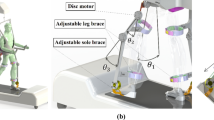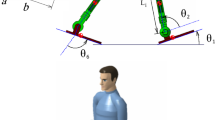Abstract
This paper proposes a novel hybrid controller for promoting safe human-robot interaction. The hybrid controller modifies a model-based impedance controller such that it uses impedance control but switches to sliding mode control under non-nominal conditions. Each control law is formulated with an inner-loop controller for feedback linearization and an outer-loop feedback controller for trajectory tracking. The outer-loop feedback torque is theoretically proven to have a smaller magnitude in hybrid control than in impedance control under an assumed condition, suggesting it may be the safer approach. To validate the mathematical assumption and purpose of the controller, a walking experiment is conducted where a healthy able-bodied subject using a lower-limb exoskeleton is randomly subjected to either hybrid or impedance control. Perturbations are induced through sudden changes in treadmill speed, resulting in operation outside nominal conditions for 15.9% of the experiment. The assumption made in the theory holds true for the majority of the experiment, failing only 14.3% of the time. The main results show a statistically significant reduction in average feedback torque magnitudes by 7.9%. This is accomplished without drastically affecting gait, with joint angle root-mean-square differences being 0.36° for the hip and 0.64° for the knee. This demonstrates how the hybrid controller can achieve similar gait patterns with lower feedback torque magnitudes, suggesting it is a promising alternative to impedance control.
Similar content being viewed by others
Explore related subjects
Discover the latest articles, news and stories from top researchers in related subjects.References
Lajeunesse, V., Vincent, C., Routhier, F., Careau, E., Michaud, F.: Exoskeletons’ design and usefulness evidence according to a systematic review of lower limb exoskeletons used for functional mobility by people with spinal cord injury. Disabil. Rehabil. Assist. Technol. 11, 535–547 (2016)
Swinnen, E., Duerinck, S., Baeyens, J., Meeusen, R., Kerckhofs, E.: Effectiveness of robot-assisted gait training in persons with spinal cord injury: a systematic review. J. Rehabil. Med. 42, 520–526 (2010)
Lee, B.B., Cripps, R.A., Fitzharris, M., Wing, P.C.: The global map for traumatic spinal cord injury epidemiology: update 2011, global incidence rate. Spinal Cord. 52, 110–116 (2014)
Bruns, J., Hauser, W.A.: The epidemiology of traumatic brain injury: a review. Epilepsia. 44, 2–10 (2003)
Maas, A.I.R., Menon, D.K., Adelson, P.D., Andelic, N., Bell, M.J., Belli, A., Bragge, P., Brazinova, A., Büki, A., Chesnut, R.M., Citerio, G., Coburn, M., Cooper, D.J., Crowder, A.T., Czeiter, E., Czosnyka, M., Diaz-Arrastia, R., Dreier, J.P., Duhaime, A.C., et al.: Traumatic brain injury: integrated approaches to improve prevention, clinical care, and research. Lancet Neurol. 16, 987–1048 (2017)
Roozenbeek, B., Maas, A.I.R., Menon, D.K.: Changing patterns in the epidemiology of traumatic brain injury. Nat. Rev. Neurol. 9, 231–236 (2013)
Mahon, C.E., Farris, D.J., Sawicki, G.S., Lewek, M.D.: Individual limb mechanical analysis of gait following stroke. J. Biomech. 48, 984–989 (2015)
Pennycott, A., Wyss, D., Vallery, H., Klamroth-Marganska, V., Riener, R.: Towards more effective robotic gait training for stroke rehabilitation: a review. J. NeuroEng. Rehabil. 9, 65 (2012)
Louie, D.R., Eng, J.J.: Powered robotic exoskeletons in post-stroke rehabilitation of gait: a scoping review. Journal of NeuroEngineering and Rehabilitation. 13, 53 (2016)
Anttila, H., Autti-Rämö, I., Suoranta, J., Mäkelä, M., Malmivaara, A.: Effectiveness of physical therapy interventions for children with cerebral palsy: a systematic review. BMC Pediatr. 8, 14 (2008)
Williams, G.R.: Incidence and characteristics of total stroke in the United States. BMC Neurol. 1, 1 (2001)
Campbell, S.K., Palisano, R.J., Orlin, M.N.: Physical Therapy for Children. Elsevier Saunders, St. Louis, MO (2012)
Alexander, M.A., Matthews, D.J., Murphy, K.P.: Pediatric Rehabilitation: Principles and Practice, 5th edn. Demos Medical Publishing, New York, NY (2015)
Wren, T.A., Rethlefsen, S., Kay, R.M.: Prevalence of specific gait abnormalities in children with cerebral palsy: influence of cerebral palsy subtype, age, and previous surgery. J. Pediatric Orthopaedics. 25, 79–83 (2005)
Christensen, D., Braun, K.V.N., Doernberg, N.S., Maenner, M.J., Arneson, C.L., et al.: Prevalence of cerebral palsy, co-occurring autism spectrum disorders, and motor functioning – autism and developmental disabilities monitoring network, USA, 2008. Develop. Med. Child Neurol. 56, 59–65 (2014)
Odding, E., Roebroeck, M.E., Stam, H.J.: The epidemiology of cerebral palsy: incidence, impairments and risk factors. Disability Rehabil. 28, 183–191 (2006)
Yilmaz, D., Dehghani-Sanij, A.: A Review of Assistive Robotic Exoskeletons and Mobility Disorders in Children to Establish Requirements of Such Devices for Paediatric Population. In: Reinventing Mechatronics: Proceedings of Mechatronics, Glasgow (2018)
Miller, L.E., Zimmermann, A.K., Herbert, W.G.: Clinical effectiveness and safety of powered exoskeleton-assisted walking in patients with spinal cord injury: Systematic review with meta-analysis. Medical Devices (Auckland, N.Z.). 9, 455–466 (2016)
Federici, S., Meloni, F., Bracalenti, M., De Filippis, M.L.: The effectiveness of powered, active lower limb exoskeletons in neurorehabilitation: a systematic review. NeuroRehabil. 37, 321–340 (2015)
Trevino, L., Vatcheva, K., Auer, M., Morales, A., Abdurrahman, L., et al.: A Single-Center Comparison Using Exoskeleton Rehabilitation for Cerebrovascular Accidents and Traumatic Brain Injury in a Cohort of Hispanic Patients. Math. Stat. Sci. Faculty Pub. Pres (2020)
Carpino, G., Pezzola, A., Urbano, M., Guglielmelli, E.: Assessing effectiveness and costs in robot-mediated lower limbs rehabilitation: a meta-analysis and state of the art. J. Healthcare Eng. 2018, 1–9 (2018)
Nolan, K.J., Karunakaran, K.K., Ehrenberg, N., Kesten, A.G.: Robotic exoskeleton gait training for inpatient rehabilitation in a young adult with traumatic brain injury. In: Annu. Int. Conf. IEEE Eng. Med. Biol. Soc. (EMBC), IEEE, Honolulu, HI, pp. 2809–2812 (2018)
Díaz, I., Gil, J.J., Sánchez, E.: Lower-limb robotic rehabilitation: literature review and challenges. J. Robot. 2011, e759764 (2011)
Bogue, R.: Exoskeletons and robotic prosthetics: a review of recent developments. Ind. Robot. 36, 421–427 (2009)
Viteckova, S., Kutilek, P., Jirina, M.: Wearable lower limb robotics: a review. Biocybern. Biomed. Eng. 33, 96–105 (2013)
Bogue, R.: Robotic exoskeletons: a review of recent progress. Ind. Robot. 42, 5–10 (2015)
Chen, G., Chan, C.K., Guo, Z., Yu, H.: A review on lower extremity assistive robotic exoskeleton in rehabilitation therapy. Crit. Rev. Biomed. Eng. 41, 343–363 (2013)
Marchal-Crespo, L., Reinkensmeyer, D.J.: Review of control strategies for robotic movement training after neurologic injury. J. NeuroEng. Rehabil. 6, 20 (2009)
Jiménez-Fabián, R., Verlinden, O.: Review of control algorithms for robotic ankle systems in lower-limb orthoses, prostheses, and exoskeletons. Med. Eng. Phys. 34, 397–408 (2012)
Ibarra, J.C.P., Siqueira, A.A.G.: Impedance Rontrol of Rehabilitation Robots for Lower Limbs, Review, in: SBR-LARS Robot, pp. 235–240. Symp. Robocontrol, IEEE, Sao Carlos, Sao Paulo, Brazil (2014)
Hogan, N.: Impedance control: an approach to manipulation: part I—theory. J. Dyn. Sys. Meas. Control. 107, 1–7 (1985)
Hogan, N.: Impedance control: an approach to manipulation: part II—implementation. J. Dyn. Sys. Meas. Control. 107, 8–16 (1985)
Hogan, N.: Impedance control: an approach to manipulation: part III—applications. J. Dyn. Sys. Meas. Control. 107, 17–24 (1985)
Asada, H., Slotine, J.-J.E.: Robot Analysis and Control. John Wiley & Sons (1986)
Mohammadi, A., Gregg, R.D.: Variable Impedance Control of Powered Knee Prostheses Using Human-Inspired Algebraic Curves. Journal of Computational and Nonlinear Dynamics. 14, (2019)
Yu, X., He, W., Li, Y., Xue, C., Li, J., Zou, J., Yang, C.: Bayesian estimation of human impedance and motion intention for human–robot collaboration. IEEE Transactions on Cybernetics. 51, 1822–1834 (2021)
Yu, X., He, W., Li, Q., Li, Y., Li, B.: Human-robot co-carrying using visual and force sensing. IEEE Trans. Ind. Electron. 68, 8657–8666 (2021)
Tran, H.T., Cheng, H., Rui, H., Lin, X., Duong, M.K., Chen, Q.M.: Evaluation of a fuzzy-based impedance control strategy on a powered lower exoskeleton. Int J of Soc Robotics. 8, 103–123 (2016)
Spyrakos-Papastavridis, E., Childs, P.R.N., Dai, J.S.: Passivity preservation for variable impedance control of compliant robots. IEEE/ASME Transactions on Mechatronics. 25, 2342–2353 (2020)
Laubscher, C.A., Sawicki, J.T.: A robust impedance controller for improved safety in human-robot interaction. J. Dyn. Sys., Meas. Control. 1–24 (2021)
Søraa, R.A., Fosch-Villaronga, E.: Exoskeletons for all: the interplay between exoskeletons, inclusion, gender, and intersectionality. Paladyn J Behav. Robot. 11, 217–227 (2020)
Dalley, S.A., Hartigan, C., Kandilakis, C., Farris, R.J.: Increased walking speed and speed control in exoskeleton enabled gait. In: IEEE Int. Conf. Biomed. Robot. Biomech. (Biorob), pp. 689–694. IEEE, Enschede (2018)
Indego Explorer User Manual Supplement 043–008-000 Rev A, Parker Hannifin Corporation (2018)
Parker Hannifin Corporation, Indego Personal Data Sheet (2020)
du Bois, J.L., Lieven, N.A.J., Adhikari, S.: Error analysis in trifilar inertia measurements. Exp. Mech. 49, 533–540 (2009)
Korr, A.L., Hyer, P.: A Trifilar Pendulum for the Determination of Moments of Inertia. Frankford Arsenal Research and Development Group Pitman-Dunn Laboratories, Philadelphia, PA (1962)
Winter, D.A.: Biomechanics and Motor Control of Human Movement, 4th edn. John Wiley & Sons, Hoboken, NJ (2009)
Rose, J., Gamble, J.G.: Human Walking, 3rd Edition. Lippincott Williams & Wilkins (2006)
Goo A, Laubscher C, Sawicki JT (2022) Hybrid Zero Dynamics Control of an Underactuated Lower-limb Exoskeleton for Gait Guidance. Journal of Dynamic Systems, Measurement, and Control. https://doi.org/10.1115/1.4053946
Tan, A.H., Godfrey, K.R.: The generation of binary and near-binary pseudorandom signals: an overview. IEEE Trans. Instrum. Meas. 51, 583–588 (2002)
Redd, J., Lyon, C.: Spectral content of NRZ test patterns. Maxim Appl. Note. 3455(49), 10–14 (2004)
The OEIS Foundation, A011673 - OEIS, (n.d.)
Winter, D.A.: The Biomechanics and Motor Control of Human Gait: Normal, Elderly and Pathological, 2nd edn. University of Waterloo Press (1991)
Laubscher, C.A., Farris, R.J., van den Bogert, A.J., Sawicki, J.T.: An anthropometrically parameterized assistive lower-limb exoskeleton. ASME J. Biomech. Eng. 143, (2021)
Goo, A., Laubscher, C.A., Farris, R.J., Sawicki, J.T.: Design and evaluation of a pediatric lower-limb exoskeleton joint actuator. Actuators. 9, 16 (2020)
Acknowledgments
The authors would like to thank the individuals at the Human Motion and Control Division at Parker Hannifin Corporation for their technical expertise and support with the Indego Explorer exoskeleton.
Availability of Data and Material
Not applicable.
Code or Data Availability
Not applicable.
Funding
Not applicable.
Author information
Authors and Affiliations
Contributions
C.A.L. developed the controller and composed the manuscript. C.A.L. and A.G. conducted the experiments. R.J.F. provided technical expertise on the exoskeleton. J.T.S. supervised and oversaw the work. All authors reviewed the manuscript.
Corresponding author
Ethics declarations
Ethics Approval
Not applicable.
Consent to Participate
Not applicable.
Consent for Publication
Not applicable.
Conflicts of Interest/Competing Interests
Not applicable.
Additional information
Publisher’s Note
Springer Nature remains neutral with regard to jurisdictional claims in published maps and institutional affiliations.
Rights and permissions
About this article
Cite this article
Laubscher, C.A., Goo, A., Farris, R.J. et al. Hybrid Impedance-Sliding Mode Switching Control of the Indego Explorer Lower-Limb Exoskeleton in Able-Bodied Walking. J Intell Robot Syst 104, 76 (2022). https://doi.org/10.1007/s10846-022-01583-7
Received:
Accepted:
Published:
DOI: https://doi.org/10.1007/s10846-022-01583-7




